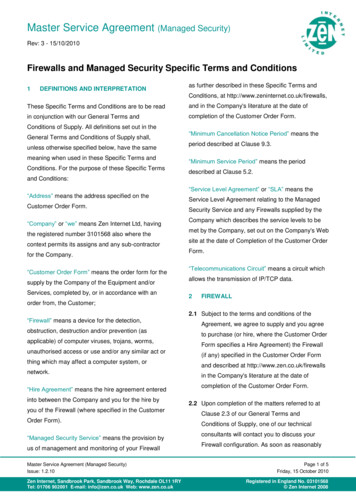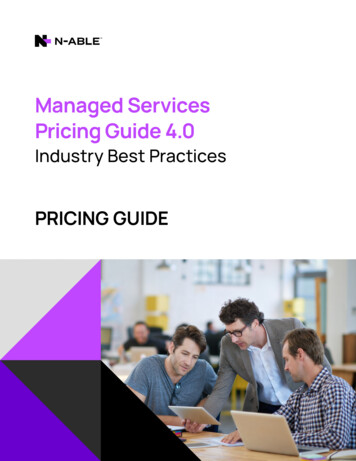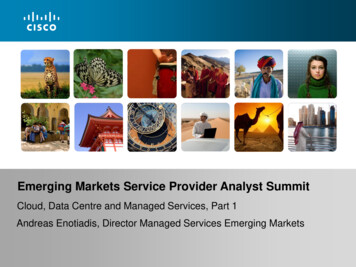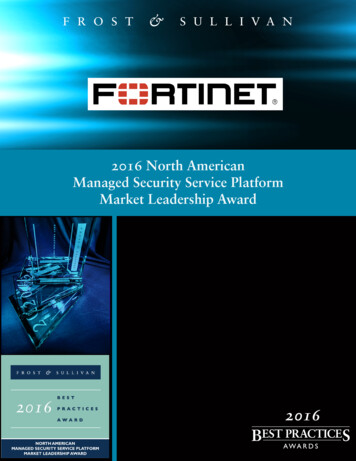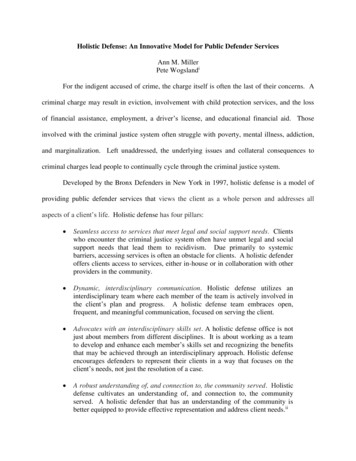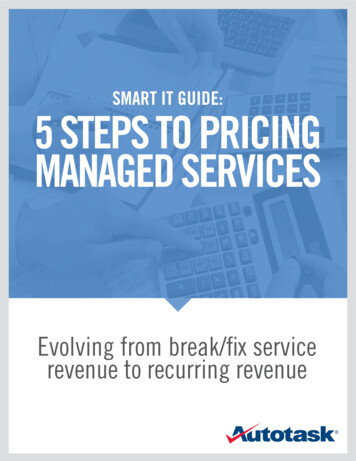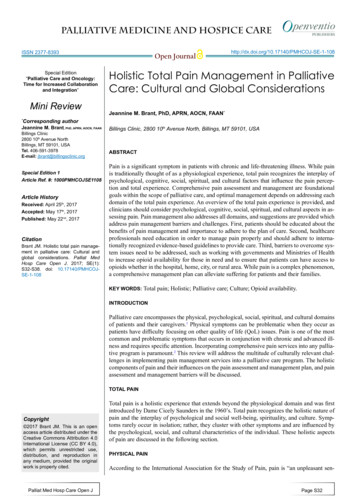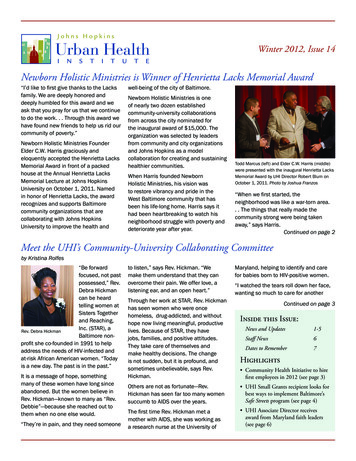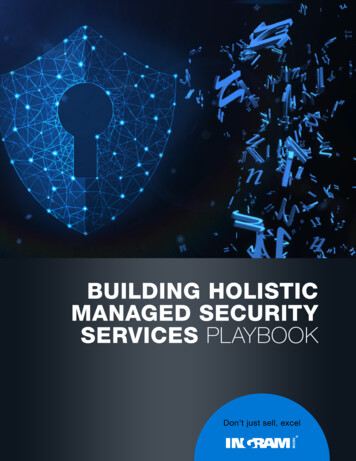
Transcription
BUILDING HOLISTICMANAGED SECURITYSERVICES PLAYBOOKDon’t just sell, excel
Table of Contents02TOC03Managed Security Services Defined15Business and Sales Models04Managed Security Service MarketOpportunity16Packaging and Pricing Options16Billing Frequency07Thinking Holistically About ManagedSecurity Services17Pricing and Go-to-MarketMistakes07090915All Companies NeedDefense-in-DepthEnd-to-End AdministrationThreat Management andIncident Response10Scaling and Expediting Security10Acceptance of Risk onCustomers’ Behalf10Trackable and AccountableBudgeting11Providing CustomersWith Options11Holistic Managed Security Essentials13Everyone Needs ManagedSecurity ServicesBuilding Holistic Managed Security ServicesPricing and Packaging Managed Security18Overcoming Security ServiceSales Objections20Best Practices for Establishing an MSSP21About Ingram Micro
Managed Security Services DefinedSecurity, by its very nature, is complex. Every data file, application, device, network connection andcloud instance requires protection from hackers, malware, unauthorized users and accidental corruption.Individual pieces of technology are complex enough on their own. Adding security to the mix only amplifiesthe technical, operational and economical challenges. The complexity and difficulty of applying, managingand maintaining security are what drives an increasing number of businesses to opt for managed securityservices.Managed security services are the delivery of security technology and support—live and automated—remotely from a service provider or cloud-based resources. Managed security sounds like a single product,but it’s not. Managed security comes in many forms, as nearly every form of security technology is availableas a remotely delivered service.The benefits of managed security are numerous. Through centralization and remote delivery, managedsecurity service providers (MSSPs) offer users scalable resources, agile response, aggregated threatintelligence, access to multiple security technologies, standardized and best practices for data protection,auditing and activity reporting, and expedited incident response. Most of all, MSSPs offer an economicalapproach to security, as they’re often sold on a recurring-revenue model that spreads the infrastructure, staffand technology cost over multiple customers.While possible to build point-managed security services, such as managed firewalls or cloud-based antivirusprotection, it’s not necessarily practical or valuable. Businesses of all sizes, from Fortune 500 enterprisesto Main Street shops, wrestle with myriad complex security issues for which there’s no one technology orsolution. Businesses need multiple synergistic security solutions, which is why the more valuable MSSPs areholistic in offering end-to-end data and infrastructure protection.This Ingram Micro Security Guide provides the information and direction solution providers need to buildrobust, holistic MSS practices. Included in this guide are helpful resources for connecting with vendors thatoffer essential products and services for building a security service business. Ingram Micro 2019
Managed Security Services Market OpportunityThe managed security service market opportunity is enormous. According to market analyst firm Gartner,worldwide spending on IT security services will top 62 billion in 2019, up 9 percent over the previous year1(see FIGURE 1: Global MSS Spending, 2017–2019). This year, security services will account for 54 percent ofall IT security spending. Growth in the managed security services segment is slowing, but the rate in NorthAmerica is still nearly five times the overall industry average2 (see FIGURE 2: North America MSS GrowthRate, 2012–2019).FIGURE 1: Global Managed Security Services Spending, 2017–2019Source: GartnerGartner, “Worldwide information security services spending from 2017 to 2019,” August 2018, de-it-security-spending-since-2010/.2Frost & Sullivan, “Growth of the managed security services market in North America from 2012 to 2019,” 2019, e/.1Building Holistic Managed Security Services
FIGURE 2: North America Managed Security Services Growth Rate, 2012–2019Source: Frost & SullivanBusinesses seek and buy managed security services for many reasons. Complexity is an overarching driver,but a lot is packed into that one word. For many businesses, regardless of size or threat exposure, managedsecurity services are about getting data protection and risk mitigation on a scale that’s independentlyunobtainable.The discrete reasons businesses engage with MSSPs include: Extend security coverage: All security practitioners are in an arms race with hackers. They need tostay current with new, emerging and sophisticated threats and attacks. Through managed securityservices, businesses can mitigate threats that they can’t address on their own. Access sophisticated security technology: Businesses can afford neither the technology nor thestaff they need to effectively mitigate risk. Managed services give them access to technologies theycan’t acquire independently. Offset security staffing shortages: There’s no secret that the world doesn’t have enough trainedsecurity professionals. Managed services provide the means of aggregating security talent that canperform activities across multiple domains. Address budget constraints: Some organizations are cash strapped to the point where they havea hard time paying for even modest security. Through managed security services, businesses canstretch their limited budgets through recurring-payment plans and operational expenses. Ingram Micro 2019
Outsource routine security tasks: Sometimes a security manager wants to focus only onsophisticated activities. Through managed security services, a business can offload routine tasks toa service provider, freeing time and resources to address more sophisticated issues. Gain access to insights and expertise: Security isn’t the focus for most businesses; it’s afunction to safeguard business operations and assets. Managed security services are (or shouldbe) performed by experts. Through managed security services, businesses gain access to domainexperts, their insights and experiences, and the intelligence drawn from serving multiple companies’needs.Demand for managed services continues to increase. According to research by The 2112 Group, nearly40 percent of vendor channel chiefs believe managed service providers will drive the majority of indirectrevenue within the next five years.3 Solution providers—resellers, integrators and MSPs—are alreadyheavily invested in the service model, with as much as 40 percent of their gross revenue generated throughrecurring-revenue offerings.4 Moreover, three of the top six services offered by solution providers are securityor security related.5 38% of channel chiefs say managed services will be the top indirect-revenue generator.3 76% of MSPs offer data backup and recovery managed services.5 62% of MSPs offer managed endpoint security services.5 59% of MSPs offer managed network security services.5Managed security services represent a significant growth opportunity. Unlike other technologies andservice offerings, security is a persistent and evolving problem. Economic swings, new applications andshifting operational priorities rarely diminish the need for security. Moreover, government regulations,privacy concerns and requirements, and investment in intellectual property are high motivators for securityinvestments. The outlook for managed security services is strong now and in the foreseeable future.The 2112 Group, 2019 Channel Chief Outlook, March 2019.The 2112 Group, 2019 Channel Forecast, March 2019.5The 2112 Group, 2018 State of the U.S. Cloud Channel, October 2018.34Building Holistic Managed Security Services
Thinking Holistically About Managed Security ServicesFew technology products or services are monolithic. The printer segment, for instance, has numeroustypes of printers, ranging from desktop to network, monochrome to color, inkjet to laser, single-function tomultifunction and more. Security is probably one of the most fractionalized technology domains because itmust address so many different types of applications, appliances and use cases.While MSPs can offer single-function managed security services, such as managed antivirus or managedfirewalls, the question is this: Why limit the value proposition when the need is dynamic and pervasive?In this section, we’ll define the different types of security needs and discuss why businesses need more thanjust single-point security offerings and how synergistic security translates into managed security services.All Companies Need Defense in DepthNo one security technology or service can address all of business data, device, and infrastructure protectionand risk mitigation needs. Some businesses and users—particularly small businesses—get lulled into a falsesense of security with one type of security—antivirus or a firewall. While some security is better than none,having one layer of security is never enough.The security industry has long advocated a defense-in-depth strategy consisting of complementary,synergistic, overlapping security technologies that work both independently and in concert to prevent,detect, analyze, respond to (stop), mitigate (minimize damage of) and recover from attacks. Defense in depthisn’t an excuse to try to sell more products and services. It’s a tested and validated strategy for minimizingrisk exposure and losses.The three primary reasons defense in depth works: 1) overlapping security technologies can address thesecurity needs of different applications, devices and infrastructure; 2) not all threats work the same, thereforerequiring different countermeasures and approaches; and 3) more layers make it more difficult for hackers topenetrate defenses without detection.To get a sense of how defense in depth works, think about the Mission Impossible movies. Tom Cruise (asU.S. government operative Ethan Hunt) doesn’t just walk through the front door to steal a file. He must firstget past the security guard with fake credentials. Then he must navigate the labyrinth of hallways and officesto find the target file’s precise location. Next, he must get through several locked doors and vaults. Once inthe super-secret vault, he must access the computer and network without setting off any alarms. And thenhe must proceed in reverse, getting out of the vault, the room, the building—essentially extracting himselffrom the dangerous situation—without detection. Such an intrusion takes time, precision and luck because,at any point, detection is possible thanks to a variety of different security technologies. Ingram Micro 2019
The basic idea behind defense in depth is simple: If one layer of security doesn’t detect and stop a hacker,the next layer will. Moreover, hackers scan and assess networks before attacks. The more complex thesecurity defense in depth, the less desirable the target network. Holistic managed security services thatprovide end-to-end capabilities provide businesses with access to defense-in-depth capabilities.Building Holistic Managed Security Services
End-to-End AdministrationA significant challenge among security practitioners is administration. Security is everywhere. Many chiefinformation security officers (CISOs), security managers and systems administrators wrestle with having toadminister security through multiple interfaces and consoles. Enterprises construct entire security operationscenters (SOCs) that look more sophisticated than the bridge of Star Trek’s Enterprise to visualize activity,receive alerts and track responses.Defense in depth is a tried-and-true approach to security and risk management. The downside is that morelayers create complexity. A goal many vendors promised the market is security under a “single pane ofglass.” In truth, that promise is more often a mirage than an oasis, as it’s nearly impossible to put all securityunder one management console. Ultimately, more complexity makes security harder to manage, administerand measure.MSSPs face the same security administration and management challenge, but, unlike end users, MSSPs doonly security management. An MSSP can essentially virtualize the security management process, providingeach customer with a single pane of glass through which to see its activities relative to its networks anddevices. Job ticketing and project management systems, such as professional services automation (PSA)tools, make it possible for MSSPs and customers to interact seamlessly on ongoing and on-demand tasks.Threat Management and Incident ResponseBased on trending data, research and surveys, the business community knows it’s up against mountingsecurity threats. The problem is that they can’t always see those threats. Even though nearly every businessin the world is connected to the internet, they can see only the threats within their immediate view. That’srather limiting.MSSPs, on the other hand, are like weather forecasters. Their support of multiple business domains, accessto reports across the internet and vendor-provided intelligence gives them extensive insight into risk andthreat trends long before anything gets a chance to hit a customer’s perimeter. Businesses that subscribe toMSSP offerings have a tremendous advantage, therefore, as they benefit from this extensive bird’s-eye viewof threats.Visibility is one benefit, but so is the ability to respond. Through this broad view of the security landscape,MSSPs provide customers with the ability to prepare for new threats before incidents can happen. AndMSSPs, through their extensive experience in dealing with security issues, can quickly respond to incidentsand remediate damage. Ingram Micro 2019
Scaling and Expediting SecurityChief benefits of managed security services are scale and speed. Security technology isn’t trivial. Everyapplication, appliance and cloud instance requires some level of security. Acquiring, deploying andmanaging security requires money, time and skill, all three of which are in short supply in business IT andsecurity departments.Managed security services provide businesses with the ability to access multiple technologies that theycouldn’t necessarily acquire or operationalize effectively on their own. Additionally, businesses can scaleup or down their use of security services with their needs. As they expand, they can quickly extend theirmanaged security to cover new assets. If they contract, they can turn off unneeded services.The scale is also about the selection of security technology. Not every business shares the same risk profile.Security isn’t about absolutes; it’s about applying appropriate levels of protection—the right tools to do theright jobs. Through managed security services, businesses can select the applications and support theyneed to meet the objectives of their security strategy.Acceptance of Risk on Customers’ BehalfUltimately, security is about risk management. Security practitioners have four options for handling risk: Avoid: Choose to bypass risky operations, business ventures, locations. Reduce: Mitigate risk exposure by reducing the level of activities or infrastructure. Share: Spread the risk across multiple partners, service providers or domains. Accept: Understand that all things have a certain level of risk and accept the consequences. Ignore: Do nothing but move forward with risky plans.Managed security services are about providers accepting and sharing risk on behalf of their customers. Thejob of every MSSP is to assume the risk of monitoring digital activity and taking responsibility for identifying,detecting and thwarting threats. Through this assumption and sharing of risk, MSSPs make it possiblefor businesses to push their operations into new markets, create new revenue sources and move moreexpeditiously.Trackable and Accountable BudgetingFew people dispute the importance of security in the modern digital enterprise. Nevertheless, security isoften seen by executive teams as a cost center. Security is a black hole that demonstrates value only whensomething bad happens. As a result, many CISOs and security managers have a difficult time tracking andvalidating the cost of their security operations and investments.Managed security services are a different matter, though, as they provide security practitioners with visibilityinto security operations and expenditures, reporting on activities, validation of security strategies, anddocumentation of security compliance with government regulations and local security policies. Securityservices are a means of accountability.Building Holistic Managed Security Services
Accountability is one thing, but budgeting is another. Many CISOs wrestle with the expense of security.Few CISOs and security administrators will say they have enough money or resources, and that’s largelya byproduct of the organizational perception that security isn’t a profit center. Through managed securityservices, a business can consolidate much of its security technology and operational cost into a singleexpense line. Moreover, managed security services enable businesses to track spending seamlessly—oftenbecause MSSPs typically bill through a recurring-revenue model.Providing Customers With OptionsHolistic managed security services don’t mean customers must buy all the security technologies, or thatservice providers must create “all-or-nothing” bundles. Rather, holistic managed security services are aboutgiving customers options. MSSPs can and should offer customers everything from data- and client-levelsecurity to network, perimeter and cloud services. MSSPs provide options for crafting the right applicationsand levels of security to counter both threat exposure and budget limitations.Studies show that customers tend to buy more managed services after their first experience. Chances arethat customers will dabble in managed security at first (see Overcoming Security Service Sales Objections),but once they get comfortable with the security process and see the benefits of managed services—availability, reliability and return on investment—they’ll likely look to expand their data and infrastructureprotection coverage. Having a holistic security practice means customers won’t need to work with multipleproviders and enables MSSPs to benefit from horizontal and scaling consumption.Holistic Managed Security EssentialsSecurity technologies range from emerging to mature, exotic to commoditized, free to expensive. MSSPscould spend years cobbling together the breadth of security technology and still have gaps in theirportfolios.Holistic managed security doesn’t mean a provider needs every technology on its line card or every vendor’soffering under its data center roof. Practically speaking, a holistic security portfolio includes technologiesthat provide core functions and benefits, interoperate for defense in depth, and offer progressive protectionagainst a variety of known and emerging threats.The following are the essential technologies and services for every holistic MSSP: Network security: Includes technologies that reside on and are administered at the network level.Firewall technology is table stakes for any organization, but network security could include suchofferings as intrusion prevention/detection systems (IPS/IDS), data loss prevention (DLP) systems,network access control (NAC), DNS and DDI security, and Web filtering systems. Ingram Micro 2019
Monitoring, assessment and reporting: Managed security providers need systems that canmonitor, analyze and assess vast amounts of information and intelligence. Security providers shoulduse or provide security information and event management (SIEM), as well as various forms of logmanagement and analysis tools. Endpoint security: Security service providers should go beyond the obvious malware protection(antivirus) and also help protect endpoints with tools such as encryption applications, softwarefirewalls, and email and messaging security applications. Identity and access management: Maintaining control over security often comes down to identityand access management. If a person, application, or machine doesn’t need or have authorizationto access a system, it shouldn’t. MSSPs can help with the identity and access management issuethrough systems management, password reset services and the delivery of multifactor authenticationsystems. Cloud security: Cloud infrastructure and application providers often include certain baselinemeasures of security with their services, although they’re often not enough. MSSPs can augmentnative cloud security with applications such as cloud access security brokers (CASBs) and virtualizedsecurity technologies (firewalls, IPS/IDS) in cloud environments. As more businesses turn to MSPs toprovide cloud management services, they’ll increasingly seek security as part of their offerings. Data backup and recovery: The last line of defense in any security scheme is backup and disasterrecovery. If all else fails, a known good copy of data and applications exists. Business continuity anddisaster recovery (BCDR) services are a favorite among MSPs and should be a part of any wellmanaged security service portfolio. Professional services: Not all security services are automated. MSSPs should offer a cadre of preand post-sales professional services, including everything from needs assessments and deploymentto integration and incident response. Professional services are a means for ensuring customers havethe right services, level of service and performance needed to safeguard their assets and complywith regulations.Building Holistic Managed Security Services
Examples of security services by technology domainNetworksecurityMonitoring andassessmentEndpointsecurityIdentityand accessmanagement Firewalls Nextgenerationfirewalls IPS/IDS Patchmanagement DLP NAC DNS security Web filteringVPNs SSL VPNs SIEM Logmanagement Auditing Securityreporting Antivirus Antispam Local harddisk encryption Softwarefirewalls Web filtering Email andmessagingsecurity Access control Authenticationandauthorization Tokens Biometrics Passwordmanagement DirectorymanagementCloud securityData backupand recoveryProfessionalservices CASBs Virtualizedsecuritytechnology Cloud-basedbackup Local backupservices Disasterrecovery asa service(DRaaS) Needsassessment Strategyplanning Policy creation Deploymentand integration Auditing Governanceandcompliancereporting IncidentresponseA holistic MSSP should have not only the core security technologies but also the management andcustomer relationship systems to coordinate activities ranging from security incident identification andresponse to service delivery and job ticketing and billing. At a minimum, MSSPs should have a PSA platformor other job ticketing system for internal and external task management.Everyone Needs Managed Security ServicesSecurity isn’t a technology exclusive to any one customer type or industry. The need for security is asubiquitous as threats on the internet. If a company needs security, chances are it’s a candidate for managedsecurity services. The question isn’t whether these different customer types need managed security; it’swhat kind of security and at what level. Enterprises (more than 1,000 employees): Large businesses have the highest risk exposure simplybased on their profile. Thousands of employees spread out across multiple offices around a countryor the world, numerous road warriors connecting to unknown Wi-Fi access points and hundredsof applications processing mission-critical data make enterprises’ need for managed securityparamount. The enterprise need for managed security spans the spectrum of security technologiesand support. However, enterprises are most likely to seek security augmentation and support ratherthan full outsourcing to a provider. Midmarket (250 to 1,000 employees): Security services are appealing to midmarket companies asthey wrestle with balancing the need for data and infrastructure protection against limited budgetsand competing priorities. Midmarket companies tend to offload their routine security tasks (endpoint,perimeter) while maintaining control of their most mission-critical data protection technologies andapplications. Ingram Micro 2019
Small businesses (fewer than 50 employees): Smaller organizations have the greatest need formanaged security, as they’re challenged with limited budget, staff and resources. Outsourcingsecurity to a service provider is the best means of accessing technology and expertise that theycan’t acquire on their own. While small businesses are more receptive to managed security services,they typically don’t need the same level of technology and service as some other companies. Regulated industries: Companies in healthcare, financial services, transportation and otherindustries subject to privacy and security regulations are prime candidates for managed securityservices. Their risk exposure goes beyond hacking threats to regulatory compliance. If theyexperience a security breach, they face fines, regulatory sanctions and reputational damage.Managed security services are a means of augmenting and strengthening security posture anddemonstrating compliance. Covered entities: Any organization that does business with a regulated company or industry, suchas a cleaning service that supports a hospital, is considered a covered entity and therefore in needof more stringent security requirements. Covered entities often fall in the small and midmarket range,meaning they have limited security resources. Managed security is a means for covered entities toprotect their data and comply with their customers’ security requirements. Government agencies: Federal, state and local government agencies often look like their publicsector counterparts in terms of security needs, budget and resources. Government agencies areprime candidates for managed security, as they often seek private sector support to augment or fullyprovide expertise and infrastructure for protecting critical infrastructure and data. Startups: Nearly all new companies start small, but many never intend to remain that way. Startupsoften have business plans and ambitions that require high degrees of security from the start. Whenlaunching, and in the early development phases, startups don’t have the budget or resources tosecure their data and infrastructure. Managed security services provide the means for securing theirinterests until they can provide their own security.Building Holistic Managed Security Services
Pricing and Packaging Managed SecurityManaged security services aren’t a product; they’re an outcome. Technology is the means of deliveringthat outcome. Pricing and packing managed security services involves, and this section will describe thedifferent approaches that can be taken. Solution providers should consider this as guidance, as there aremany ways to establish prices for services.Business and Sales ModelsBefore establishing a pricing strategy and structure, an MSSP must decide what types of technologies it willsell, the vendors it’ll work with and how those vendors go to market with partners. Typically, services aresold in three ways.Go-to-market modelDefinitionSales modelSell-toIn the sell-to model, vendors sell technologyto partners for use in the delivery of managedsecurity services. The partner, not the customer,takes title to the product.Partners incorporate vendor products into theirservice delivery platform and establish customerpricing independently.Sell-throughIn the sell-through model, solution providerssell the vendor’s managed security service andcollect a commission or a share of the recurringrevenue.The vendor establishes the customer price, andthe partner receives a commission. Partnerscan earn extra revenue by selling attachedprofessional services.ReferralUnder the referral model, the simplest of thethree, the partner simply sends the vendorcustomer references.Typically, partners receive a one-time reward orcompensation for deals that the vendor closes.Referrals provide few value-add opportunities forthe partner.For purposes of this guide, the model of choice is sell to, as it provides MSSPs with the most options fordeveloping high-value managed services. The sell-through and referral models are good choices for MSSPsthat don’t want to develop infrastructure and resources for supporting customers; correspondingly, theydon’t have the same revenue and profit potential. Ingram Micro 2019
Packaging and Pricing OptionsEstablishing a packaging and pricing model is a logical extension of the go-to-market framework. Howmanaged security services are sold typically dictates the pricing for different types and levels of services. Cost-plus pricing: Unless an MSSP is developing its own security technology, it must acquireproducts and services from security vendors. A simple means of establishing a customer price iscost plus, in which the cost of the service is the base price the vendor charges the MSSP, plus thecost of sales and operations. For instance, a vendor may charge 100 per seat for a security serviceor technology, so the MSSP will charge 150 to the end customer. Preset bundles: Itemized pricing can cause customers to scrutinize the cost of security services.Customers, particularly SMBs and midmarket companies, are price sensitive. Creating bundles oftiered and overlapping services allows an MSSP to conceal the underlying pricing and margins fromthe customer and emphasize the value of the service. Preset bundles also have the benefit of makingservices a faster, easier sell. Hybrid model: Nothing says an MSSP has to have prepackaged bundles and menu options. In thismodel,
FIGURE 2: North America Managed Security Services Growth Rate, 2012-2019 Source: Frost & Sullivan Businesses seek and buy managed security services for many reasons. Complexity is an overarching driver, but a lot is packed into that one word. For many businesses, regardless of size or threat exposure, managed
